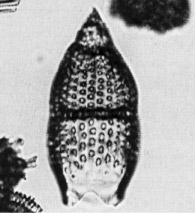 Podocyrtis
(Lampterium) acalles Sanfilippo and Riedel
Podocyrtis
(Lampterium) acalles Sanfilippo and Riedel Podocyrtis
(Lampterium) acalles Sanfilippo and Riedel
Podocyrtis
(Lampterium) acalles Sanfilippo and RiedelPodocyrtis (Lampterium) acalles Sanfilippo and Riedel, 1992, p.12, pl.3, figs.2-5
Three-segmented pterocorythid with a broad-based vaguely lobed cephalis, bearing a short bladed horn. The lateral lobes of the cephalis have small irregular pores. Thorax campanulate, with pores in rows separated by longitudinal ridges. Lumbar stricture marked on the external contour by a slight indentation. Abdomen approximately the same length as the thorax, cylindrical to slightly inflated, terminating in a broad hyaline peristome bearing three wide shovel-shaped feet. The abdominal pores are slightly larger than the thoracic ones, in later forms arranged in rows separated by longitudinal ridges. Earlier forms tend to have abdominal pores that are irregular in size and arrangement but with some development of discontinuous ridges. (Sanfilippo and Riedel, 1992).
Based on 40 specimens. Length (excluding horn), 170-240 µm; length of cephalothorax, 90-115 µm; width of thorax 85-115 µm; width of abdomen 90-130 µm (Sanfilippo and Riedel, 1992).
This species is transitional between Podocyrtis (P.) papalis and P. (Lampterium) sinuosa. It is distinguished from P. papalis by the presence of a slight external lumbar stricture, and from P. sinuosa by the proportion of thoracic length to abdominal length (1:1 in the former, and 1:1.5 to 1:3 in the latter) (Sanfilippo and Riedel, 1992).
From its first appearance near the boundary between the Buryella clinata and Phormocyrtis striata striata Zones, P. acalles characteristically occurs in large numbers in early Eocene assemblages (up to 2% of the total) to paleolatitudes of 45° (Sanfilippo and Riedel, 1992).
The evolutionary transition of P. acalles to P. sinuosa occurs in the Theocotyle cryptocephala Zone.